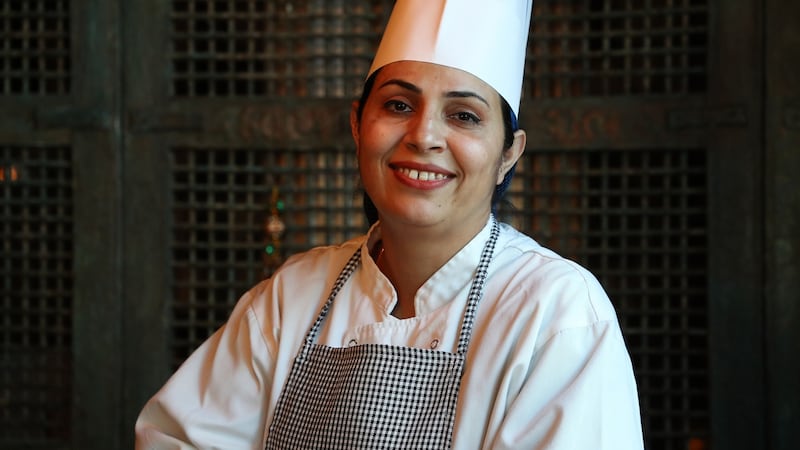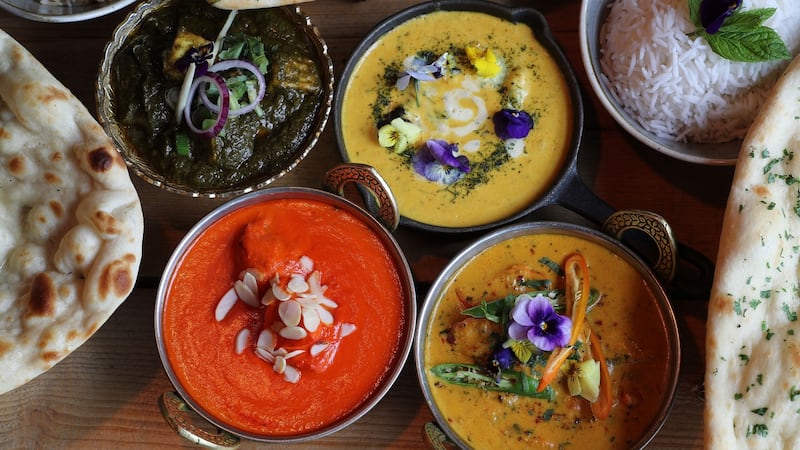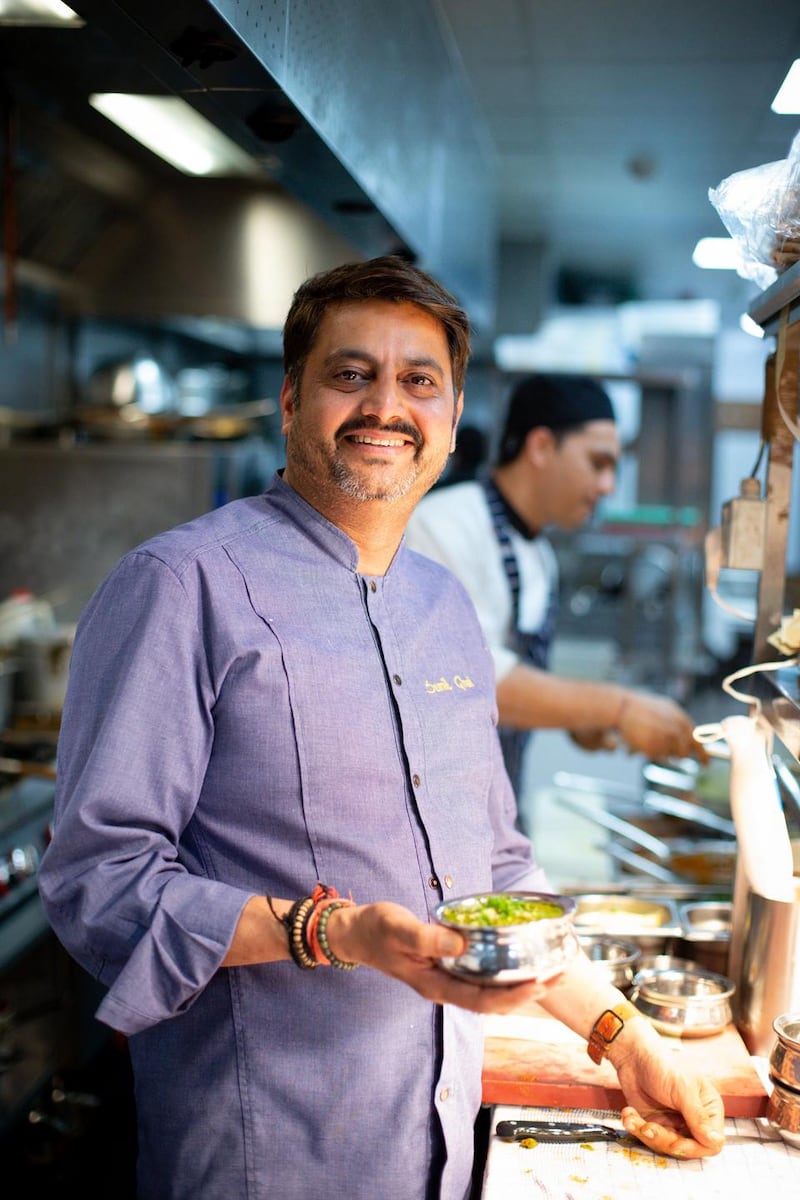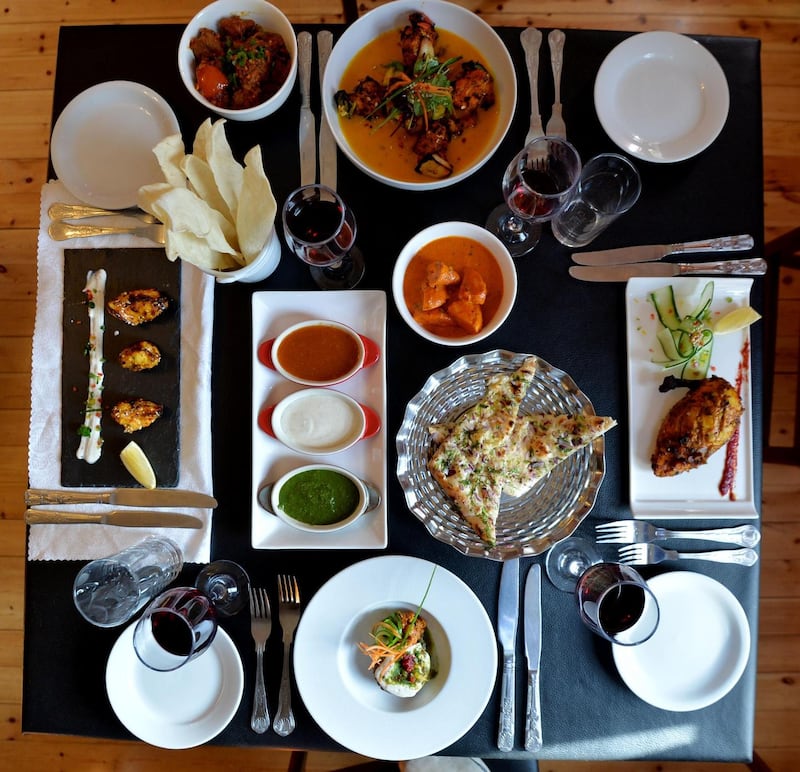To tackle the topic of Indian food in Ireland is to tease a thread out of a complicated tapestry, and here we can offer only the briefest glimpse. India is, while nominally a country, more a continent, with myriad religions, languages, and landscapes.
What's more, so-called "Indian food" in Ireland includes the countries of Pakistan, Nepal and Bangladesh. There is coconut milk and seafood in the south; tandoor and street food in the north. Take Rogan Josh, a dish of braised lamb and spices from mountainous Kashmir that would be familiar to many Western customers. Muslims brown shallots, onion and garlic before adding the lamb to the pot; Hindus eschew these and often thicken with yogurt; the dish traditionally features the dried Kashmiri chilis and is coloured red by flower stamens and roots.
Ireland and India have had a mutual thrall, since Dean Mahomed landed on the shores of Cork in 1784, married a Cork girl called Jane and, with his book Travels, became the first Indian writer ever published in English. (He would later open the first Indian restaurant in England and a chain of spas, enter into a bigamous marriage with another Jane, and coin the word shampoo. Such was the potency of Mahomed's Bengali charm.)
The two countries share a history of being colonised by England. In St Stephen's Green, there is a bust of the Bengali poet Rabindranath Tagore, who was a pal of Yeats. In Delhi, there is a street named after Éamon de Valera. One of the great freedom fighters in India was an Irish woman named Annie Besant, who was elected president of the Indian National Congress in 1917.
This is not to say that the Irish escaped India lily-white; some of the most brutal members of the English Raj army were Irish, such as Michael O’Dwyer, who was the governor of Punjab during the Amritsar massacre. Still, says Arun Kapil, who owns the Irish spice company Green Saffron, “there’s a reason why the Indian and the Irish flags are the same colour. . . . There’s a synergy between the countries.”


Even though there are not a lot of South Asians in Ireland, people say that, in general, there is less prejudice. "Colour didn't seem to matter so much," says Kapil, who grew up in England. "Ireland is more inclined to accept you as a blank slate." Rahat Saeed, owner and chef of Daata in Greystones, who is from Pakistan, says: "On arrival [my brother-in-law] Saleem noticed little to no other brown people but could not have been more welcomed." Also in the kitchen, which she runs, she observes, "There is no gender hierarchy for me."
The first Indian restaurant opened in Dublin in 1908, called the India Restaurant and Tea Rooms, and closed a few years later. But Indian spicing was not unfamiliar; Irish soldiers in the Raj were partial to "curries". Moreover, Cork and Waterford were spice ports since late medieval times – a list of spices available in Ireland from 1302 to 1468 include almonds, cloves, dates, galangal, pepper and saffron.
Fragrant
Kapil says: "You see spices regularly as part of everyday [Irish] cooking." He points out that drisheen – blood pudding – is fragrant with mace; spiced beef has nutmeg, juniper, peppercorns, cloves and allspice. Kapil adds: "At some point there were two saffron-growing regions in Ireland, just outside of Limerick. "
The 1930s and 1940s saw a more direct relationship between the two countries; not just politically, but also in tea and spice trading, when during the second World War, England cut off Ireland’s tea supply, and so Ireland began trading with India directly. (Irish tea is distinctively stronger and maltier than English brews.)
India Restaurant, which opened in Dublin in 1939, catered to the growing number of Indian students at Trinity College. In 1956, the Kashmiri, Kenyan-born Mohammed "Mike" Butt opened up the Golden Orient, a glamorous hotspot, and went on to help found the Restaurants Association of Ireland.

In the 1990s, the influence of hotel chain Oberoi (the Ritz Carlton of India) came to Ireland. Specifically, Oberoi alumni Asheesh Dewan of Jaipur restaurant on South Great George's Street in Dublin and Nisheeth Tak of Rasam in Dún Laoghaire came to Ireland with ambition and vision, and were united in a desire to best communicate authentic Indian food, while negotiating with the fact that there was no coriander available in shops here.
The response from the South Asian community was positive. Also, Dewan said, in the early days, the best customers for Jaipur were the clientele from the neighbouring gay bar The George.
Oberoi is in many ways the Genghis Khan of fine dining Indian restaurants in Ireland, in that if you look at a fancy Indian establishment here, you can find Oberoi DNA. Their offspring dominate the high-end Indian scene today, including Sateesh Sayana from Ruchii in Blackrock, Co Dublin, Sunil Ghai from Pickle on Camden Street, Sanjay Vishwakarma from Sanjay's Kitchen in Birr, Co Offaly, and Shoaib Yunus from the Kinara group of restaurants.
Great influence
Another great influence comes from Pakistan. Chefs remark that Pakistani food is better suited to Irish tastes. For one, it is more meat-oriented, such as Peshawari Namkeen Gosht, a lamb rubbed in garlic and roasted whole. But it is worth noting that Pakistan is very much its own country, predominantly Muslim. One proudly Pakistan kitchen that has stood out in the Irish restaurant scene for years is Kinara Kitchen, whose co-owner Shoaib Yunus is another former Oberoi employee. Their dish of Nihari Gosht is highly spiced coriander and ginger beef, a meat that is forbidden for Hindus, but also precious to the Irish.
Food is a passion for many Indians; they wax about it with a poetry and precision that another person might use to describe a painting, a book or a rollercoaster ride. “You want food to be happiness,” says Sanjay Vishwakarma of Sanjay’s Kitchen in Birr.

He tells me about his mother's fish curry: very simple with fresh tomatoes and water, "like a bouillabaisse", flavoured with spices that she crushes between two stones. Karan Mittal, head chef at Ananda restaurant in Dublin, describes how his grandmother dries each of her spices in the sun. Neeti Agnihotri of Jaipur in Dalkey talks about her mother's crispy dosa (rice pancakes) and fresh tomato chutney in the mornings. Agnihotri's mother, Ameeta, is a food critic back in in Chennai, southern India, so the family spreads tend to be lavish: roti, curry and two vegetable dishes for supper.
Vishwakarma recites a litany of ingredients for which he longs: “Good asafoeitida, black stone flower, Lakadong turmeric, found in Meghalaya. Yoghurt chili, red chilis soaked in buttermilk and dried in the sun, royal cumin and cumin.”
Street food
Street food snacking in northern India is also missed. Vishwakarma remembers “hot samosas wrapped in newspapers, sizzling golgappas [puffed pastry balls stuffed with various fillings] in patterned cardboard plates, fresh aloo tikki [fried potato cakes] in small hand-woven bowls .”
“We were in Rajasthan,” Mittal adds, “and there were ladies selling pancakes made of maize and buckwheat that they were cooking on stones, which they served with potato and a simple pickle.”
Many Indians are also health-obsessed, abiding by Ayurvedic principles (which is about balance between hot and cold) but also Western rules of calorie intake and fat. “Cumin,” says Mittal, “has a cooling effect on the body. Cloves are a digestive.” For this reason, Indian home-cooked food is not represented in Irish restaurants. Indian food at home is healthy, while the food at many Indian restaurants here is rich. “You can eat Indian food every day,” Anubhav Shrivastava, who lives in Dún Laoghaire, tells me, “but if you ate Indian food out every day, you would die.”
Because Indians are serious about what they eat, it also means that they are critical. In Ireland, many remark that meat that is eaten in India is consumed on the bone, which is more flavourful, but distasteful to Irish customers. Another struggle is introducing the bitter and the sour, so fundamental to Indian flavours. “My mother,” says Sanjay Vishwakarma, “does a bitter melon kebab stuffed with a potato masala that just melts.” Plus, there’s a different style to the way Indians and Irish eat. “Irish people love their single plates,” everyone mourns. In India, everyone sits down together and eats communally, with a number of dishes that are always shared, which allows for variety. And if you’re eating out at a restaurant, children will come with you.
Vegetarian
Yet things are changing here. There is coriander, chili and turmeric at Tesco. There is an appreciation for goat, which in many regions of India is preferred to lamb; and the goat is local and delicious. Also, there's a move towards vegetarian food, like the popular all-vegetable brunch at Daata.
Coriander restaurant in Clondalkin recently celebrated the Kerala festival of Onam, a vegetarian feast of 25 separate bites, spread on a banana leaf.
Some mourn that there is not a singular regional experience – as of yet there is no restaurant in Ireland that represents a single regional cuisine. Indians, when they eat out, are craving something new, whether it is tandoor (“my family doesn’t have an oven”) or the food of another province. For this reason, many Indians living in Ireland mention Sunil Ghai’s Pickle restaurant, for Ghai represents his region of Gwalior.
Traditionally, Indians eat sitting around the table together and with their hands. Obviously, in these Covid times, to eat in this fashion is fantasy. There’s a term, “son-mat” – not Indian, but Korean – which means taste of hands. When you eat something that is son-mat, transmitted is the various stories of the people who have made it. I think son-mat is as applicable to India as it is to Ireland, a culture that relies on memory and physical contact.
“If you are in love with food,” says Sanjay Vishwakarma, “you want to be reminded of childhood, and that gives happiness.”











